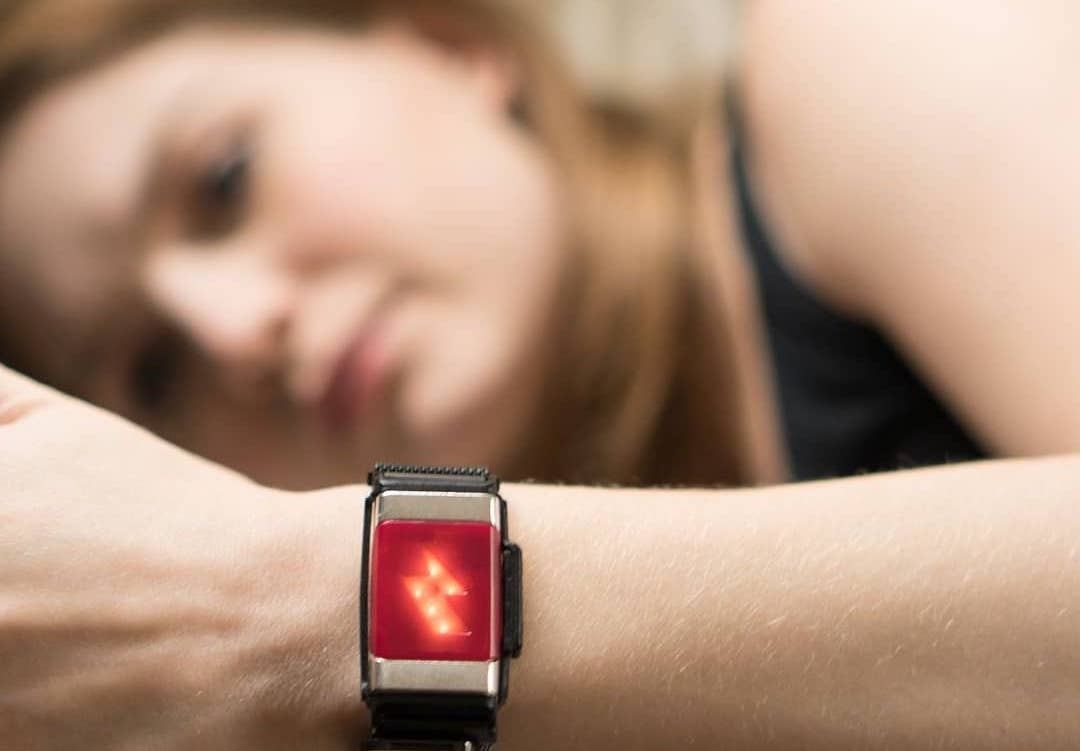Some dog owners swear that the shock collar is the key to training success. When a dog barks or tries to leave the yard, they receive a small shock reminding them that doing so results in a wee bit of pain. Now, the same training process is available to those of us trying to ditch a bad habit like ordering fast food. You can literally shock yourself out of temptation, and… are we sure this is a good idea?
This new accessory aimed at helping people quit a habit like biting their nails or chomping into a Big Mac is called the Pavlok bracelet, and the second generation is currently available on Amazon for $199.
According to The Verge, the Pavlok is named after Russian Nobelist Ivan Pavlov, who discovered classical conditioning — when a neutral stimulus (for example, a bell) is matched with a biological stimulus (food), and results in a reflex (salivation) whenever the neutral stimulus is presented. However, the Pavlok is based on operant conditioning and aversion therapy, which is when a person/animal is punished for a specific behavior, and therefore associates that behavior with pain and hopefully avoids the behavior altogether.
Yes, operant conditioning can work to train dogs. But can one train themselves with aversion therapy to break a habit?
[fm_youtube url="https://www.youtube.com/watch?v=FP88Gji98sU"]It depends. In order to receive a zap from the Pavlok bracelet, a user must zap themselves via the Pavlok app, which means that a person is completely in control of their own fate — to zap or not to zap? That is the question.
Sound familiar? Thought so.
“I tried the Pavlok for over a month and my conclusion is: it doesn’t work,” Verge contributor
“But at the end of week one,” Potenza wrote, “I resumed biting my nails more fiercely than ever and I did something I found extremely liberating: I ignored the Pavlok on my wrist.”
But how will it know I'm in the In-n-Out drive-thru?
— Dude_In_The_Desert ❁ 🌵 (@t_arnpreeest) June 18, 2019
The device vibrates when the user brings their hand to their face as a warning to think twice. But this happens even if you’re not eating fast food or biting your fingernails — you could simply be itching your cheek and receive a vibrating tingle, meaning that it’s easy to just forget about it.
So the @amazon Pavlok bracelet works by administering a small electric shock if you eat too much fast food, bite your nails, or spend too much time on the Internet. Um... are these different shocks for each habit or...?
— Kathleen Smith (@MrsDrAtlantis) June 17, 2019
But others seem to swear by Pavlok, insisting that it truly helps them curb their cravings to engage in bad behavior.
One Amazon reviewer wrote, “Armed with my pav 2, I was able to make it through my first post-recovery flight without drinking a drop. I looked at the airport bar, I shocked myself. I thought about drinking, i shocked myself. I smelled someones alcohol, i shocked myself. And I repeated this trigger-shock pattern until eventually, seeing or smelling or listening to people drink no longer caused a craving for me. It’s hard to overstate what a relief this was for me.”
I wouldn't make it out alive. pic.twitter.com/2ayNN6Ipzq
— Glen Beeby (@GlenBeebyNews) June 18, 2019
The most recent Pavlok bracelet also has a feature where other people can control your Pavlok shocker so they can hold you accountable if you don’t trust yourself. To us, that sounds like a surefire way to never trust your friend again, but…
Break your bad habits with @pavlok ...or give it as a gift! Does your significant other have a habit you’d set Pavlok to “help” them break!?? **biting nails, eating junk food, binge-watching #Riverdale** https://t.co/ZjKc9VUuBf
— Ty Bentli (@TyBentli) June 17, 2019
To each their own, we suppose. We don’t think we would like the feel a surge of 350 volts of electricity every time we went to munch on a chicken nugget. But hey, some people out there would.
What about when your bad habit is buyong stuff on Amazon?!
— Ryan Travis (@rttravis) June 18, 2019
Currently, there aren’t many in-depth studies about the Pavlok and if it actually works. The company paid the University of Massachusetts, Boston, to run a study, which found that six out of 10 participants were able to quit smoking using Pavlok for a week.
But because only 10 participants were studied over such a short period of time, the study is not nearly broad enough to make any conclusions.
Nope. pic.twitter.com/VdFWGgieU2
— Deryck (@Canoe_Ideas) June 18, 2019
Furthermore, it’s not yet proven that the Pavlok works for the long-term. How do we know that once you ditch a habit, you won’t pick it back up when the fear of shocking yourself is gone?
We think we’d rather try to quit our nail-biting and fast food-eating habits cold turkey before donning the Pavlok. Sorry.
We hate getting yelled at, but we like this idea better. What can we say? We don’t like being in pain!
Yikes. Literally us all the time if we had the Pavlok:
No more French fries??😭🤷🏾♀️😂 pic.twitter.com/gmqnnu8AAV
— 💙🦂Scorpiogirl2🦂💙 (@NellyBelle3379) June 17, 2019
Somehow, some way, this would happen. We know it.
I’d be dead
— Carolyn (@cab0113) June 18, 2019
If you’re brave enough to give the Pavlok a go, we salute you. Tell us how it feels and if you think it works.
Or, hear me out: don't do it
— 🤷🏾♀️ (@aquariusthawts) June 17, 2019
We are simply too sensitive. Not today, Pavlok. Not today.

